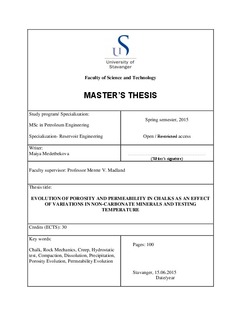| dc.description.abstract | Pressure decline during oil recovery from chalk reservoirs exhibit increase in effective stress and this in turn leads to reservoir compaction causing seabed subsidence. Although, there is positive impact of compaction on the oil recovery, the necessity of pressure maintenance brought the introduction of water injection to chalk fields in the southern part of North Sea (eg. Ekofisk and Valhall). Sea water injection has successfully resulted in an increase in petroleum output. However, as sea water displaces oil and increases pore pressure, the reservoir continues to compact. The phenomenon is referred to as the water weakening effect on chalks. Since little was understood about the impact of aqueous chemistry on the mechanical behaviour of chalk reservoirs, there have been several many studies to better understand this phenomenon.
In the present study, the main goal is to get an improved understanding of how variations in original porosity, non-carbonate content, in addition to temperature effects on final porosity, dynamic compaction and permeability evolution when injecting chemically reactive brine.
Chalk cores from two different sources, one pure chalk (Mons, 99.5 wt% calcite), and one containing a higher non-carbonate content (Kansas, 97.5 wt% calcite) were tested in hydraulically operated tri-axial cells. Chalk cores were isotropically loaded beyond yield and thereafter left to deform at a constant stress (creep) for 60 days. Test temperatures were 60°C, 92°C and 130°C, while MgCl2 brine was used as injection fluid.
Results from the conducted compaction experiments show that the porosity evolution is in coupling with the change in bulk volume, induced by the applied stress, as well as with change in solid volume due to rock-fluid interactions involving dissolution/precipitation processes induced by temperature. Moreover, it has been observed that implication of dissolution/precipitation has also effect on flow properties and to a great extent depends on temperature and non-carbonate minerals initially present in the chalk. Chemical analysis of the effluent show that at high temperatures (92°C and 130°C), considerable loss of magnesium and excess production of calcium is observed, thereby promoting volumetric change of solid phase. Scanning electron microscope images of newly formed magnesium-bearing minerals support the effluent analysis. | nb_NO |
